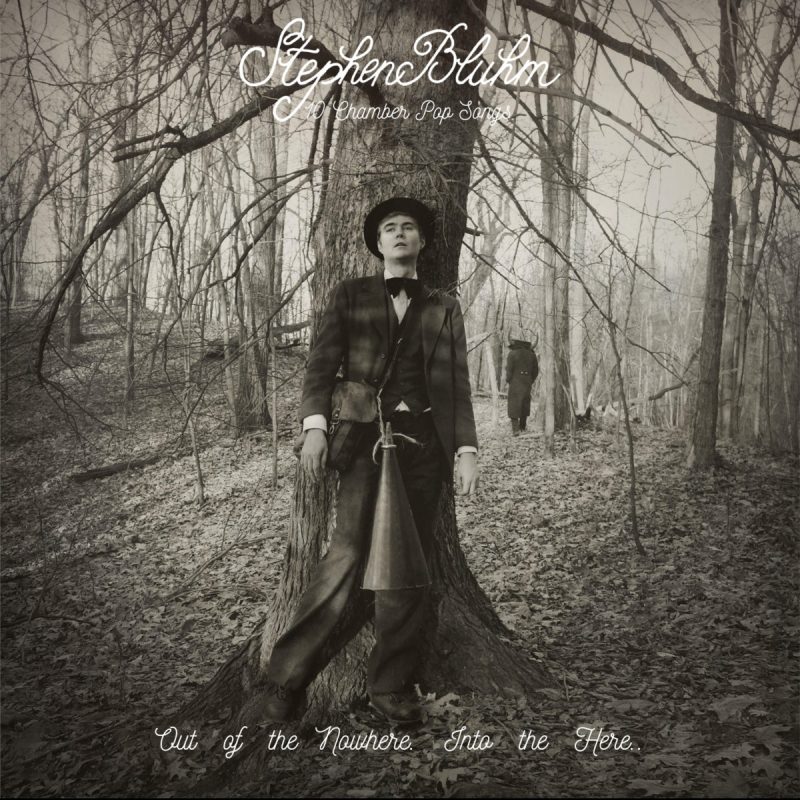As I enter the arms of a woman,
Truly fortunate.
As I went the arms of the autumn, so familiarly.
As a coda, the cold of the winter, under covers
We.
In a tale as old as time, a young visionary finds their calling in music, an escape from the constraints of a sleepy rural Pennsylvania hometown. But it’s a rare breed who can translate that escape into something as strikingly heartfelt as Stephen Bluhm’s exquisite second album, Out of the Nowhere, Into the Here. This beautifully crafted collection of chamber pop stands out not just for its emotional depth but for its lush, detailed compositions. Bluhm as a true artist to watch.
Stephen Bluhm’s 2017 self-titled debut dazzled as a synth-pop powerhouse, but with Out of the Nowhere. Into the Here., he takes a different path. Opting to shelve the synths this round, Bluhm dives deep into the lush territories of both modern and classic chamber pop, a genre he’s cherished for ages. His musical heroes are clear and present throughout the album: you can hear the clever lyrical twists reminiscent of Magnetic Fields and Brian Dewan, the unguarded symphonic romance akin to The Divine Comedy, Rufus Wainwright, Bowie and John Cale, and the ornate, direct dialogue that fondly nods to Sondheim’s patter songs and Richard Hawley.
You would have to have a heart of stone to not be affected by this sublime collection, which Bluhm describes as “ten intimate but playful songs capturing the visceral feelings of autumn and winter, love and passion, and the suspicion (I’m not alone with) that there is something going on beyond our understanding.”
Stephen Bluhm not only recorded, mixed, and produced his latest album, but he also assembled a powerhouse of guest musicians to bring it to life. The album is a lush orchestration of strings, horns, flutes, piano, and reeds, crafting a full-bodied, richly layered soundscape. It’s an ambitious effort that still manages to feel deeply personal and intimate, pulling listeners into its finely crafted world of sound. This album marks another bold step for Bluhm, showcasing his knack for blending grand musical architecture with heart-touching melodies.
“As I put these songs and arrangements together for the album, I became more and more confident in them,” says Bluhm. “I just hope people sense the beauty in them, the genuineness that I put into them.”
The opening track, Any Little Thing, is a tantalizing first glimpse into Bluhm’s charming, emotionally intricate world. Laying out the album’s classical/cabaret calling card, it couches its tender, romantic lyrics and Sondheim-ian melodies in caressing strings and gentle piano.
The playful Wissahickon is a heartfelt tribute to the Philadelphia creek that offered sanctuary and inspiration to Stephen Bluhm during his college days. The song weaves tales of its storied past, from the mystical Brothers of the Wissahickon, a 17th-century religious group led by Johannes Kelpius who also found divine refuge in its woods; to its role in hosting America’s first paper mill and inspiring the writings of Edgar Allan Poe. Bluhm captures the creek’s enigmatic spirit with brilliant lyricism (Tom Lehrer comes to mind) and his warm, distinctive baritone, creating a track that’s both a nod to history and a showcase of his lyrical prowess.
The Moon & The Twelve Tones evokes a wintry, introspective scene under a low-hanging moon, capturing feelings of solitude and the cycles of nature. The song reflects on presence and absence, with a haunting backdrop of snow and fleeting moments. It concludes with meditative, almost spiritual exclamations of acceptance and eternity.
Everything Is Better Now That You’re Around exalts the transformative effect of a loved one’s presence, illustrating how loneliness and darkness vanish when they’re near. The speaker acknowledges their flaws and fatigue when alone, highlighting how the other person’s presence brings joy and improvement to their life and surroundings, emphasizing a recurring sense of relief and happiness.
Easter expresses deep gratitude and affection, listing moments of gratitude and emphasizing a prayerful wish for the beloved to remain unchanged, despite growing older and wiser. It culminates in a repeated blessing for the beloved’s well-being. Existential Crisis explores the complexities of a non-conventional relationship, blending intense emotions with acceptance. It highlights moments of passion visible even in anger, emphasizing the importance of self-reflection.
The spiritual I Never Feel Alone describes the existential fear of loneliness mitigated by a deep-seated faith and the constant presence of a higher power. The speaker reflects on the challenges of daily life, from sleepless nights to routine workdays, finding solace in faith and occasional communication with a missed loved one. The song conveys a personal journey of maintaining health and confronting fears, both in dreams and reality.
All the Love You Want offers a heartening ode to the virtues of diligence and perseverance, positing that these qualities invariably pave the way to success and contentment. The song is suffused with promises of abundant love and a flourishing existence, intricately weaving the rewards of hard work with the allure of distinguished achievement and profound emotional fulfillment. Our Autumn paints an intimate portrait of a couple embracing the transition from Summer to Fall. It captures moments of closeness and comfort, set against the backdrop of changing seasons and nature’s beauty. The song reflects on shared memories and the warmth found in each other’s company as winter approaches.
Finishing out the album is There Was a Light, a powerfully vulnerable and introspective item inspired by the composer’s pondering an accidental mystical experience with kundalini: “Many songwriters wonder about the strange feeling when a melody suddenly appears in your head from out of the nowhere,” he says. ‘Set to a piano and string arrangement, There Was a Light captures, in an honest and matter-of-fact way, a bit of what it was like to have a startling kundalini awakening when I thought about where melodies come from. In its vulnerability, the song seems to have a power of its own.”
Listen below:
Out of the Nowhere. Into the Here. by Stephen Bluhm
Since childhood, Stephen Bluhm has been steeped in music, but it was the Lou Reed and David Bowie albums belonging to his older siblings that truly sparked his teenage musical fervor. While studying at Temple University, he dove headfirst into live performances through campus open-mic nights, soon making a splash on Philadelphia’s vibrant music scene. Later, moving to New York’s Hudson Valley, Bluhm refined his dynamic stage presence. Despite the often solemn content of his songs, Bluhm’s live shows are exuberant affairs, with him frequently dancing wildly among the thrilled crowds.
Out of the Nowhere. Into the Here., available in both vocal and instrumental versions, is out now. This expansive release includes formats such as 12” LP vinyl, CD, digital download, and streaming platforms. A special 2xCD set will feature both the vocal and instrumental tracks. Coinciding with this, the instrumental version will also be available separately across digital and streaming services. The album’s ethereal and instantly memorable artwork is the result of a collaboration with the renowned duo Kahn & Selesnick, known for their work with Amanda Palmer, the Waterboys, and Shearwater.
Follow Stephen Bluhm:
Website
Instagram
Bandcamp
Soundcloud
The post Listen to the Lush Chamber Pop of Stephen Bluhm’s New LP “Out of the Nowhere Into the Here” appeared first on Post-Punk.com.




